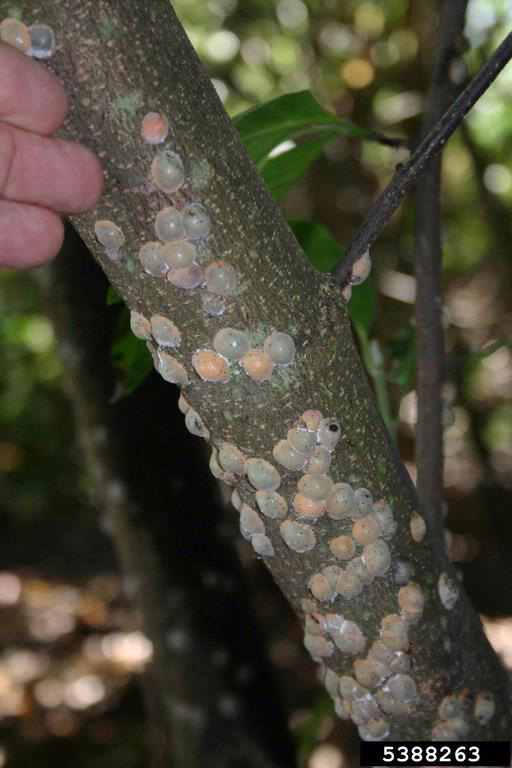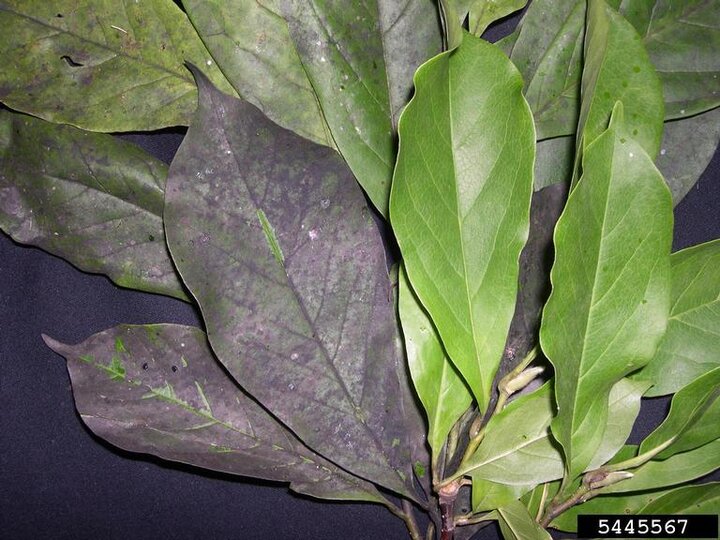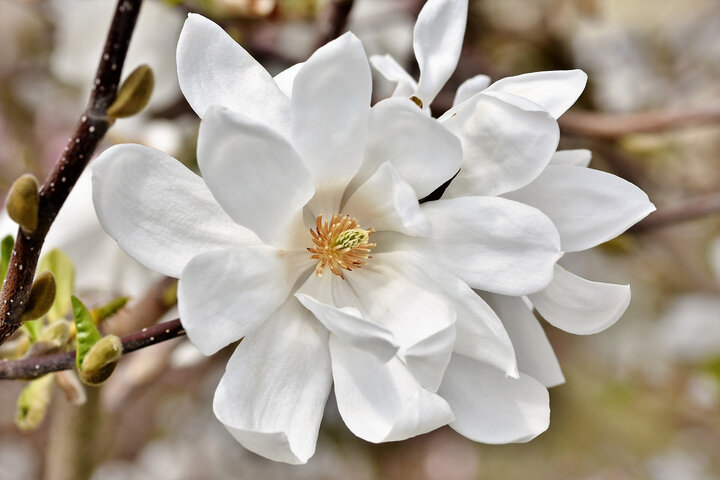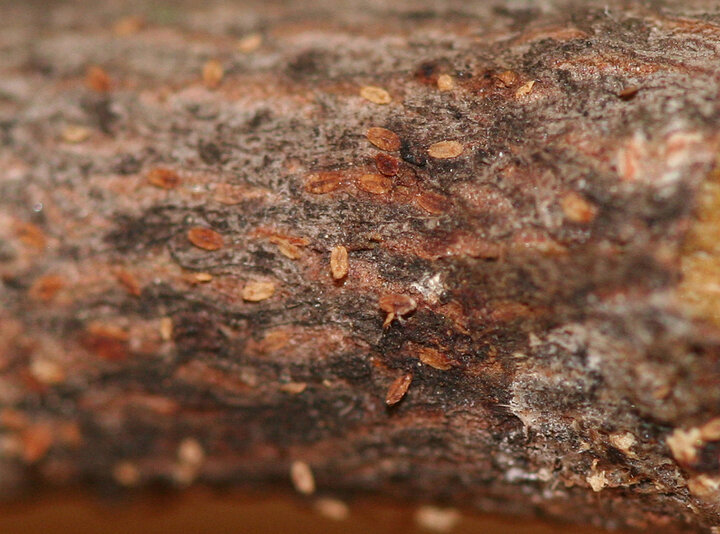Sarah Browning, Nebraska Extension Educator

Adult magnolia scale in tree bark (5388263-ppt.org). William Fountain, University of Kentucky, Bugwood.org
If you have a saucer or star magnolia in your landscape, magnolia scale is a troublesome insect. At this time of year, they make their presence known by causing sap to rain down beneath infested trees. Anything below, like patio furniture or cars, gets a sticky coating. An integrated approach is necessary for control, targeting the most vulnerable life stages at specific times of year.

Plant Damage
What would you look for to identify magnolia scale? This insect is the largest scale species found in Nebraska, but they can still be hard to spot. One way to identify an infestation is to look for the symptoms they cause on the plant. Heavy infestations weaken plants, causing leaf yellowing or killing entire branches. But the first symptom most gardeners notice is often a black moldy coating on their magnolia’s leaves.
Insects feed by inserting their needle-like mouth into a stem and sucking up plant sap. They secrete excess plant sugars, which drop to foliage and branches beneath. This creates a sticky, shiny coating often quickly colonized by black sooty mold. Look for sticky leaves and branches, or plant parts with a black moldy coating.
Scale insects feed on plant stems, not on the foliage, so that’s where to look for them. Females do not move once they have found a feeding site on a stem. Insect populations can build up to the point that stems are completely encrusted with scale. Usually at this point the stem dies. But these insects blend into the plant so well, many gardeners overlook them even after the plant starts to have visible symptoms.
What do They Look Like?
Adult females reach up to ½” diameter at maturity in late July and early August. Each female insect is covered by a soft, irregularly shaped shell, shaped somewhat like a contact lens, which is shiny and light brown. By mid to late-August, the female’s shell turns white as it is covered by a thin coating of wax. Mature males have a similar shell, although smaller. They pupate under their shell in late July and early August then emerge resembling tiny flies, which fly to the females for mating.
Females give birth to tiny, amber-colored nymphs which hatch out from mid-August through late September. These nymphs are called “crawlers” because at this point in their life they have legs and can move around on the plant to find a feeding site. Once nymphs begin feeding, they create a protective shell and stay in place until the males mature or the females die. But they are susceptible to insecticidal control during the crawler stage. If crawlers are not controlled, they will overwinter on plant stems.
Next year, in late spring, the overwintered nymphs begin feeding again and will continue to do so until late July into early August. At which time they mature, lay new eggs, and the cycle begins again.

Avoiding Problem
Stressed trees are more susceptible to attack, so keeping your tree healthy and vigorous is a simple way to prevent problems. Proper pruning, watering, mulching and avoiding overfertilization of trees will help reduce their susceptibility to magnolia scale.
How do I Control Them?
Since scale insects are difficult to control, a multi-pronged approach is most effective.

Systemic soil drench - In early summer, a soil drench application of a systemic insecticide can be used. The same product is available under many different brands, but all are usually called Tree and Shrub Insect Control and contain the active ingredient imidacloprid. Measure the tree's trunk circumference at 4.5 feet up from the ground to determine the amount of product needed. Use 1 ounce of product per inch of trunk circumference. Once applied, plant roots will take in the chemical and it will be moved to all parts of the tree or shrub. To reach full strength within the plant takes time - one week for a small plant and up to 3 months for a very large tree. Application is easy - just mix the chemical in water and pour around the base of the trunk. Read and follow all label directions on the specifics of application.
Guidelines and Restrictions
- There should be no plants that bloom growing beneath treated magnolias. Blooming annuals and perennials should be relocated or all their flowerheads removed in years when this systemic product is applied.
- To protect pollinators, systemic products should not be applied to blooming plants like magnolia until AFTER blooming is done.
- When applying during dry periods, generously water the plant the night before treatment.
- Follow product restrictions on the total amount of product which can be applied per acre per year.
- Make only 1 application per year, no more.
Fall contact spray - When the next generation of crawlers hatches in mid-August, they can be killed with a contact insecticide. To determine when crawlers emerge, place double-sided tape around a few infested branches, then watch for the amber-colored crawlers which will get stuck on the tape.
Horticultural oils, also known as summer oils, are a good product to use. Since they are not traditional insecticides, but instead are highly refined oils, they are very safe to use around humans, pets, wildlife and other beneficial insects. Oils can be applied from mid-August until freezing temperatures occur in fall. Crawlers must come in contact with the oil to be killed, so thorough spray coverage in the tree or shrub is essential.
But remember, just because a pesticide, like horticultural oil, is considered safe and low toxicity doesn’t mean it can’t damage plants. Use caution when applying oils; they can burn leaves if applied when temperatures are too hot or when applied to drought-stressed plants. Never spray landscape plants with a pesticide if air temperatures will reach 85°F or above during that day. Water plants well a day or two before application and wait until moderate temperatures occur to make your applications. Read and follow all pesticide label directions before use.
Dormant season contact spray - Horticultural oil can also be reapplied in early spring before the flower buds begin to swell, to smother some of the overwintering nymphs. For good control, it’s important to get thorough oil coverage on plant stems.
Physical removal - Heavily infested branches can be pruned out at any time of year and can help greatly to reduce the overall insect population. On smaller plants, use a plastic dish scrubber to scrape scale shells away from the bark, being careful not to damage the bark itself.
Because magnolia scale is tough to control, at least 2-3 years of treatment are often needed to reduce insect populations to a manageable level.
More information, including pictures.
Magnolia Scale, The Morton Arboretum.
Images:
- Sooty mold on magnolia leaves (5445567-ppt.org) Sarah Vanek, Bugwood.org
- Star magnolia flowers. Pixabay.com
- Newly hatched magnolia scale crawlers. The Morton Arboretum.
Search Our Archive
Associated Video
Scale Insect Control
Nebraska Extension Entomologists Jody Green and Jonathan Larson discuss scale insects and their control.